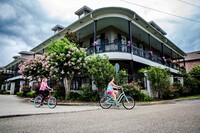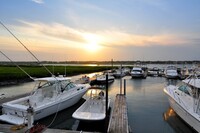By Victor Block
New Orleans, Louisiana; Reno, Nevada; and Monterey, California; have a long list of attractions and appeals for visitors. They extend beyond the frantic fun and frivolity of the annual New Orleans Mardi Gras, Reno's clutch of casinos and Monterey's seaside setting and world-class aquarium.
Travelers who are drawn to these and other metropolitan areas throughout the country frequently fail to include small towns in their itinerary that are a short drive away and also have much to offer. From chapters of history to collections of antique automobiles to covered bridges, these towns provide a welcome and often overlooked add-on or alternative to their larger nearby neighbors.
Both Covington and Mandeville, Louisiana, a convenient commute from New Orleans, trace their foundings back to the early 19th century. They served as popular weekend destinations for well-to-do residents of the city, and vestiges of that history remain.
In Covington, these include the HJ Smith & Sons General Store and Museum, which has been family owned and operated since 1876. Among items on display are a 1920s gas pump, old farming tools and a hand-operated wooden washing machine.
A place of pride in Mandeville, which was founded in 1834, is the green space laid out by the town's organizer. It features a walking and biking path, grand historic homes and groves of ancient oak trees overlooking Lake Pontchartrain. Hints of New Orleans live during concerts and music jams at the Dew Drop Jazz and Social Hall, which traces its birth back to 1895. Adding to the small-town connection is a paved rails-to-trails path that connects Covington, Mandeville and several other towns.
Different pages from the past are turned at other towns worth a side trip. At the T.B. Sutton General Store in Granville, Tennessee, located about an hour's drive from Nashville since the 1880s, browsers and buyers check out old-fashioned candies and toys, classic cookbooks and other items of past eras. Among must-sees at the Pioneer Village attraction is a quilt collection, a historic barn packed with old farm equipment and a collection of cars that date back to the 1920s.
The heart of Murrells Inlet, South Carolina, a suburb of the popular Myrtle Beach vacation destination, is listed on the National Register of Historic Places. Founded in 1731, it served as a busy port, hangout for pirates and site of early American rice plantations. Today it's a commercial and recreational fishing village where red drum, king mackerel and flounder are among the plentiful catches.
Another community known for fine fishing is perched near the other U.S. coastline: Moss Landing, 20 miles north of Monterey, California. Charter boats take anglers to spots teeming with salmon, bass, albacore and other denizens of the deep. The pristine white sand at Moss Landing State Beach attracts sun-worshippers and swimmers. Wildlife-watchers venture into the Elkhorn Slough, which is home to sea otters, sea lions and a virtual aviary of birds.
The Nantahala River, which is popular for outstanding trout fishing and whitewater rafting, and scenic Fontana Lake are water features associated with Bryson City, North Carolina, a tiny enclave an hour away from Asheville. They contrast with nearby Great Smoky Mountains National Park, which contains some of the highest peaks in the Eastern part of the United States and has been the most-visited national park for many years.
Despite its size (population about 1,500) this miniscule mountain town boasts an excursion train, rich Cherokee Native American culture and the Road to Nowhere, a 6-mile-long street that offers views of mountains and Lake Fontana and ends at a quarter-mile-long tunnel that's used by horseback-riders and hikers carrying flashlights.
Dahlonega, Georgia, a short drive from Atlanta, is another Appalachian mountain town with two major claims to fame. Its foothills' location and grape-friendly growing conditions produce award-winning wines. It has the highest concentration of vineyards, wineries and tasting rooms in the state.
The golden hue of local white vintages echoes the local gold-related history. In 1828, more than two decades before the Western gold rush, the largest deposits of that precious metal east of the Mississippi River were discovered in the area. One reminder of those heady days is the shining dome of Georgia's capitol in Atlanta, which owes its sheen to the Dahlonega gold of which it's made.
A different kind of covering attracts visitors from nearby Indianapolis and elsewhere to Rockville, Indiana, a little town with a big allure. It's not only home to what's said to be the most photographed span in the Midwest, the Bridgeton covered bridge, it also is a perfect starting point for exploring Parke County, the self-proclaimed "Covered Bridge Capital of the World."
Of a previous total of 53 roofed viaducts, 31 remain intact. The oldest dates back to 1856, while the 245-foot Bridgeton bridge was built in 2006 after its predecessor was destroyed by fire. Rockville is a good starting point for finding and photographing these throwbacks to earlier times during the Parke County Covered Bridge Festival, which takes place each October, while viewing the bridges can happen at any time of year.
This is but a sampling of small towns with big attractions that vie with those available in larger cities not far away. You might wish to check ahead of your next trip in the United States to learn if one or more of these hidden gems is worth a detour.
WHEN YOU GO
louisianatravel.com
tnvacation.com
hammockcoatsc.com
mosslandingchamber.com
explorebrysoncity.com
dahlonega.org
coveredbridges.com



Victor Block is a freelance writer. To read features by other Creators Syndicate writers and cartoonists, visit the Creators Syndicate website at www.creators.com.
The Bridgeton covered bridge is in Parke County, Indiana, known as "the covered bridge capital of the world." Photo courtesy of Visit Indiana.






View Comments